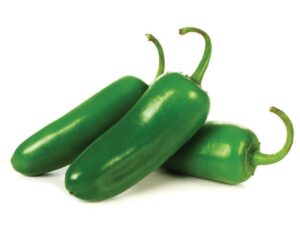Add a Little Kick to Your Diet This Month with Some Jalapeños!
Jalapeños — small yet mighty peppers originating from Mexico — have made their way into cuisines around the globe, adding bursts of flavor and heat to dishes. They are favored for their anti-inflammatory properties and nutrients. So, grab your food prep gloves (you’ll need them) and a jalapeño, and let’s spice up your next meal.
Check out these recipes:
Choose jalapeños that are firm and shiny, and avoid those that have wrinkles or bruises on the skin. Most people prefer smooth jalapeños that are about two-to-three inches long since they’re a bit milder than their larger counterparts. Grocery stores often offer red and green jalapeños; the red ones are typically spicier.
To make the peppers even milder, remove the middle portion, which contains the seeds and ribs. We recommend wearing nitrile gloves when preparing jalapeños because the oils that are released from cutting may cause a burning sensation when they come into contact with your skin.
Keep your peppers crisp and flavorful by storing them in a paper bag in the crisper drawer of your refrigerator for up to one week.
Now that you have your jalapeños on hand, you may be wondering how to use them. Don’t worry — we’ve consulted an expert. Troy Gauthier, System Director of Culinary & Contracting, Food and Nutrition Services, CommonSpirit Health, shares his favorite three ways to use jalapeños:
- Eat them fresh
An easy way to spice up your day is to include raw, diced jalapeños in an omelet, breakfast potatoes, salads, cornbread, lemonade or limeade, casseroles, stews, mac n’ cheese or anywhere you’d like a little heat.
- Roast them
Do you savor a bit of charred favor? Use roasted jalapeños anywhere where you would use them fresh. You can roast them in the oven at 425°F for 15-20 minutes, flipping once halfway through. Or, for the best charred flavor, roast them on a medium heat grill for 5-10 minutes per side until the skin is charred and the pepper is softened.
- Pickle them
Pickled jalapeños can give your dishes a delicious tang and bring fiery flavor to classic foods such as tacos, nachos, burgers or hot dogs. For best results, let your pickled peppers cure in the fridge for a few days. Try this recipe for a quick pickled jalapeño.
If you’re introducing kids to jalapeños for the first time, the key is to start small. Add just a hint of the pepper at first, and then, you can gradually ramp up the heat if your kids enjoy it. Try pairing the heat with something sweet (for example, adding a few diced jalapeños to mango salsa), or including hints of jalapeño in familiar meals such as pizza or mac n’ cheese.
Although we wouldn’t eat jalapeños as a side dish or meal (no thank you, heartburn), we can still enjoy a few bonus benefits of adding one or two of these little peppers to our meals. They add flavor without many calories and are a good source of vitamin C. The chemical that creates the heat in these peppers, known as capsaicin, has anti-inflammatory properties.
And while you’re preparing your next jalapeño-infused meal, think about these fun facts:
- Capsaicin, the plant chemical that gives jalapeños their heat, is an ingredient in some pain-relief creams and patches because it has been shown to help block pain messages to the nerves; just remember not to touch your skin directly with a cut jalapeño or the oil from a jalapeño because it can cause a burning sensation
- If your mouth is burning after a particularly hot pepper, eating yogurt or drinking milk may help tame the burn
- Jalapeños are on the milder side for hot peppers, with a rating of 2,500-8,000 Scoville Heat Units (SHUs) on the Scoville Scale, which measures the spiciness of peppers and other hot foods. For context, the scale ranges from 0 to over 2 million SHUs
- Red jalapeños are older than green ones (the green ones were picked earlier in the ripening process)
- Jalapeños were the first type of peppers that traveled to space on a NASA shuttle
- Jalapeños originated in Mexico, and today, over 40,000 acres of land in Mexico are dedicated to growing them





